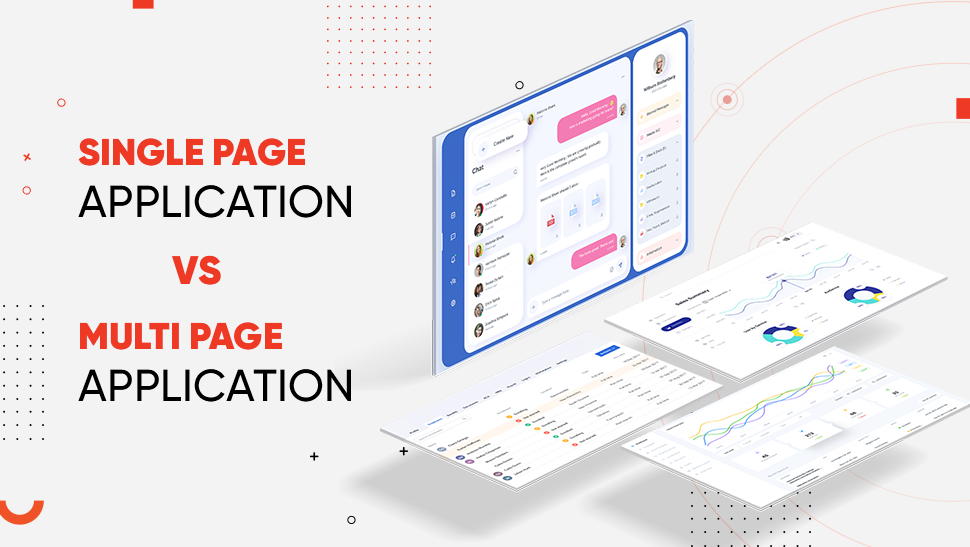Today we’re discussing SPA Vs. MPA (Single page applications Vs. Multi-page application) and their pros and cons to see which option is the best for you in 2022.
How would this information help you? Well, developing an app has become imperative for businesses because an app has become directly related to your business’s growth.
In fact, according to research by Statista, the app market is expected to hit $465,655m in 2022. Therefore, knowing which type of app you want to build for your business is critical before developing your app.
Choosing the wrong app architecture would cost you more than you expected, not to mention you’ll end up with an app that isn’t meant for the audience you’re targeting.
And among the multiple app architectures, you could choose to lay the foundation of your app, SPA Vs. MPA seems to be the most popular option available.
Let’s jump right in and spot the differences between SPA Vs. MPA and see which one is the best for businesses in general.

What is SPA?
SPA or Single Page Application enables you to work inside a browser while eliminating the need to reload a page when the user is using it.
Today, we’re surrounded by SPAs. Email providers, namely Gmail, navigation apps like Google Maps, and social media platforms like Facebook are some great examples of SPAs.
The stunning UX of a SPA acts like a browser and eliminates the need for reloading a page by maintaining the minimum possible code.
The code that SPA maintains is based on JavaScript frameworks which is the reason for the high performance of SPA.

What is MPA?
Opposite of SPA is MPA or Multi-Page Application, which reloads each time the user opens a new page in the browser.
In general, MPAs are great for massive applications as they can consist of a large number of pages that are refreshed every time the data on them is changed.
MPAs are widely considered the conventional way of app development even though you get multiple levels of UI with them.
Moreover, with the developments of AJAX, developers were able to create fast and dynamic pages in MPA that exchanged a small amount of data with the server so that the page could stay updated without reloading each time data is changed.

Differences Between SPA and MPA
The difference between SPA and MPA is that MPAs secures each page to its core. Therefore, it takes more time and effort to maintain the security; hence, page loading time is more.
SPAs secure endpoints faster, but the security level is low. SPAs generally rely on JavaScript. This makes them vulnerable to being attacked by cybercriminals because of the data not being compiled for security.
SPAs are considered more “modern” and attuned to today’s agile development needs.
However, this doesn’t mean that MPAs don’t work out. Have you ever used Amazon? The world’s largest eCommerce website? Amazon is an MPA and this effectively means that whenever you request new content, the page has to reload all over again. This is considered conventional architecture, but it’s still highly valuable and is used with great results.
MPAs are best suited for complex websites that do not require a continuation of approach. For e.g. on Amazon, you don’t require your page to stay the same when you want to view a product or category. So if you are thinking of building, let’s say a very large eCommerce site, then you should opt for an MPA architecture.
But wait! That’s not the only thing you should take into account before making the final decision. There are others as well.

Search Engine Optimization Friendliness
If you have any understanding of SEO, then you might have guessed already that MPAs will be far more SEO friendly than SPAs.
That’s because, MPAs can be used to create multiple pages, which means you can target a far greater number of keywords to rank for. This will automatically improve the amount of organic traffic you can get from Google.
And it’s just not that, SPAs are also technically not quite well adapted to the way search engines work. JavaScript, in which SPAs are developed, is not recognized by search engines mostly.
Also, MPAs have multiple HTML files due to more pages, which is more suited to the way search engines function since they primarily crawl HTML pages through initiating a download on them.
Now you understand why Facebook, despite having probably the biggest content repository in the world at the moment, doesn’t rank for much except its own site?
If you are planning to develop a SPA, you will have to market it through other means because SEO isn’t a major option available to you in this scenario.

Providing The Best User Experience
The user experience should be your top priority if you are building any digital entity in today’s world. With that being said, both, SPA and MPA offer different kinds of optimized user experience.
SPAs allow continuation, mobile-friendliness, and ease of access. Mobile apps are also developed on the same architecture as SPAs, so you can get the idea of how they complement the same experience as them.
But if creating an optimized information architecture is your priority to power a better user experience, then you need to opt for an MPA.
You can add as much content to it as you like. Continuing with the example of Amazon, the main “user experience” there is the number of products available on the platform.
So in terms of user experience, both MPAs and SPAs come good, and the variance here is subjective, based mostly upon what aim you have in mind to create the app.

Security & Vulnerabilities:
Cross-site scripting attacks XSS can be much more easily launched on a SPA than an MPA.
If such an attack were to take place, client-side scripts can be added to the SPA, making it effectively redundant and compromised for any type of usage.
With SPAs, you also have to be careful with your initial page load.
If you are not, then data exposure can occur which shouldn’t have, making your application vulnerable.
On top of this, code compilation cannot be don’t on JavaScript, which is what SPAs are based on. This, again makes them more vulnerable.
In comparison, the only major security vulnerability in an MPA is that the cybersecurity team will have to work hard to secure a high number of pages.
Both of these are increasingly complex to handle on the security front, but generally, SPAs are much more vulnerable to attacks and malware than MPAs.

Scalability:
For obvious reasons, SPAs are not inherently scalable. There is only so much you can put out on a single page.
On the other hand, MPAs can be scaled virtually endlessly. Just add more server-side resources to create more content and as many newer pages as you like.
That’s exactly the reason why eCommerce sites can’t even be feasible on SPAs. Who exactly would like to scroll down 8 minutes to find the best air conditioner or jacket to buy?

Ease Of Development:
MPAs require more time in development since they are more complex and larger than SPAs.
Another major factor elongating the development process for MPAs is the heightened interaction it needs to have between its front end and back end, each of which requires a separate framework.
This makes it harder for developers to develop an MPA.
In a SPA, the front and backend are not that inter-related which effectively means you can have teams working on both fronts simultaneously, thus allowing you to reach the launch date faster.
MPAs have another issue i.e. you have to start from scratch while writing a code for it.
On the other hand, in SPAs, code is literally reusable if you want to use it for developing a mobile app from it.

JavaScript Based Issues:
The JS framework you use within your SPA defines the performance of your whole application so if you use a limited resource framework, then your app will not have good performance.
Also. JavaScript can be disabled by the user in the browser, so if it’s turned off, expect your SPA to perform even worse since most of it won’t even load.
SPAs cannot do without JavaScript but MPAs can, which saves them from such major issues arising from the SPA’s total dependency on JavaScript.

Speed and Responsiveness:
There are no points for guessing here as to which one of them loads faster and is more responsive.
SPAs don’t require the app’s resources to reload every single time there is a content request from the user, so it’s faster.
While MPAs can be sluggish if the user doesn’t have an optimal connection or if the server isn’t responding well.

SPA Vs. MPA: Which One Is The Best For Your App?
If you are thinking of making a web app for your business, then you are heading in the right direction. By 2022, cloud-based applications are estimated to be worth around $101.3 billion in their overall market value.
Web apps are apps that work in the browser and don’t require users to download and install them.
You can consider them as an app working on the platform of a website, providing users with the best of both worlds.
But before you go any further, you should contemplate the kind of architecture your web app will have.
Apps of any kind need to afford the user with incredible performance and speed if they are priming themselves to become successful.
In today’s world, as a business you have two architecture options when developing a web app i.e. you can go either with a Single Page Application or a Multi-Page Application.
Each of these two architectures is now being used widely, albeit by the platforms whom they suit perfectly. And like all else, they too have their own distinct benefits and disadvantages.
Overall, you will need to know more in detail about SPA vs. MPA, before you make any final decision.
And we are going to help you out with this!
This article will provide you a descriptive overview of what exactly SPA and MPA are, what their pros and cons are, and in which niche do they suit the best.

How To Make The Final Choice – SPA or MPA?
There is no one clear winner here as both have their advantages as well as pain points.
SPAs are faster, more responsive, and can even augment your efforts in building a future mobile app by providing reusable code, but it still isn’t SEO friendly.
MPAs are highly scalable, better on the security front, and even support complex content and data architectures, but they can be slower and more resource-intensive to create and maintain.
If you want to create an eCommerce store, an MPA would be the right fit for you, while if you want to create an agile social platform, then a SPA would work best for you.
The final decision you make in this regard should be majorly dependent upon the business goals you have with your web app and the kind of support the architecture is willing to lend in order for you to realize those goals.
If you follow this approach, there is no way you can’t make a great decision between a SPA vs. MPA on what architecture to choose for your next web app.
Still, confused between SPA VS MPA? Need other mobile app development services? Contact us to let us decide for you.
- GET IT DONE TODAY

 2323 Views
2323 Views March 17, 2022
March 17, 2022









